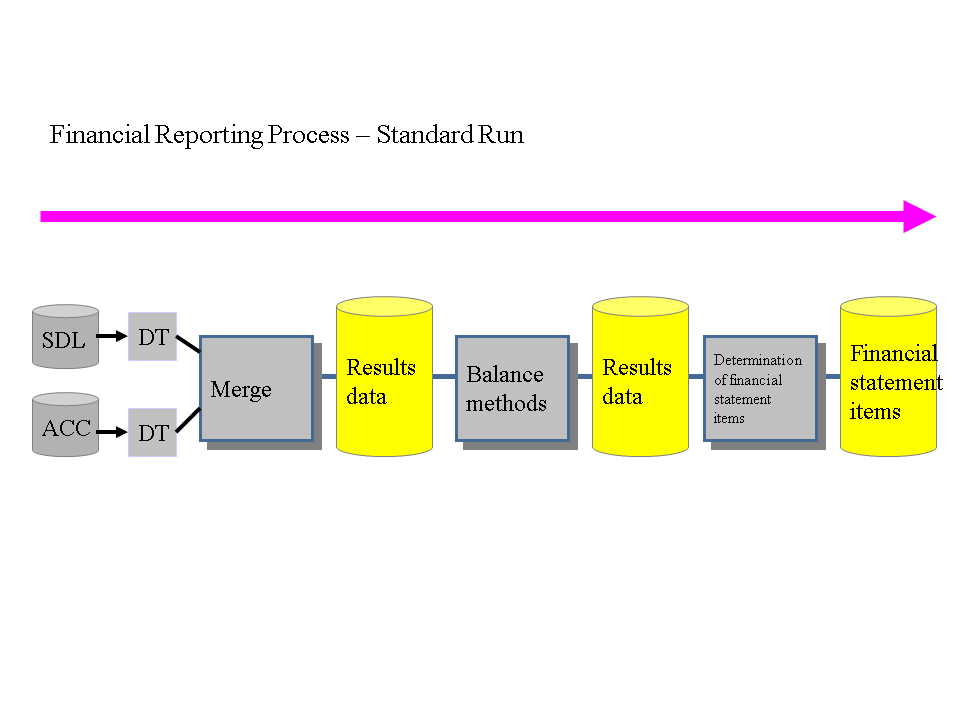 Financial Reporting Process
Financial Reporting Process
The financial reporting process is a sequence of different programs that generate data for a financial statement (balance sheet, profit and loss statement, appendix) for external accounting. The following types of financial statements can apply:
· Year-end closing
· Month-end closing
· End-of-quarter closing
There can be several financial reporting processes for each financial statement. A distinction is made between standard runs and correction runs. The first financial reporting process for a balance sheet is also known as an initial run and is always a standard run. The other financial reporting processes for a balance sheet are usually correction runs.
Financial reporting processes can extend over a period of several weeks until the final statements have been created, accepted, and published.
A financial reporting process is always assigned to a balance sheet. A financial statement created by Balance Analyzer has the following attributes:
Legal entity
Accounting system
Fiscal year, period
Value category
For more information, see Features of the Financial Reporting Process.
Corrections in the Financial Reporting Process
Corrections can be made in Balance Analyzer and in the SDL. To process the corrections and include them in financial reporting, a new process has to be started after corrections have been entered. Depending on the type of correction (correction to SDL objects, results data, and so on), the financial reporting process can be executed using a different flow definition. The flow definition used must contain the steps required to process the effects of the corrections completely.
Example:
When results data from the local GAAP accounting environment has been corrected, you have to start a process with a flow definition containing the following steps: merge, IAS
and local GAAP
balance methods, determination of financial statement items (rule set), creation of reports for IAS and local GAAP.
Corrections that are made during an active process are not considered in this process, but have to be placed in a worklist and processed in the next process after the active process. The system does not allow you to correct data that is being changed by the active process.
Example:
Corrections cannot be made to IAS results data for an object while a process is active that changes the IAS results data for that object.
Correction functions are not included in flow definitions, because the flow definitions contain only the steps that are required AFTER corrections have been made and which process the effects of the corrections. The actual corrections are made manually and result in the financial reporting process being repeated either in full or partially. The correction functions themselves are not part of the financial reporting process.
For more information, see Manual Corrections in Balance Processing.


Prerequisites
The SDL data-population process has been completed. If a master data transfer, external business transaction postings and secondary business transactions updates are necessary, the processes must be run as subprocesses of a financial reporting preprocess .
Process
A financial reporting process always starts with the creation of a financial reporting process and finishes by closing the financial reporting process.
When you have run the Close Financial Reporting Process program, programs within the closed financial reporting process can no longer be started. You first have to create a new financial reporting process, in which you can start programs again. The previous process for the same balance sheet has been closed.
When a financial reporting process is complete, the system displays an application log.
 Note
Note
To run a financial reporting process, you can schedule programs in a flow definition in Schedule Manager or you can start the individual steps of the financial reporting process in the individual transactions.
For more information, see Financial Reporting Process and Schedule Manager.
For example flows, see Examples of Financial Reporting Process.
Result
When all the financial reporting processes for a financial statement are finished, data is available for the balance sheet, profit and loss statement, and appendix.